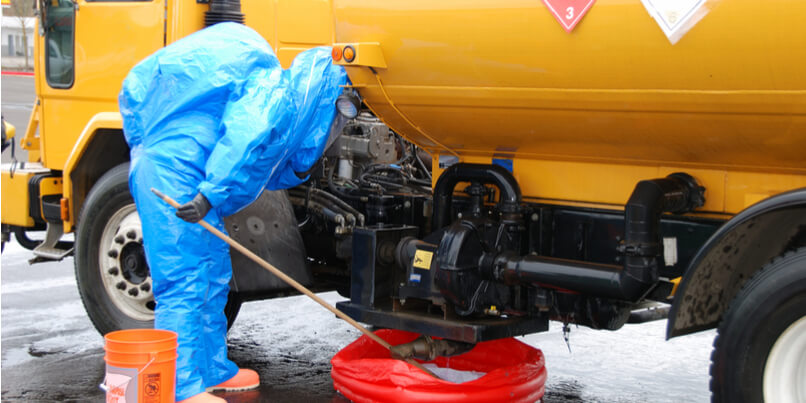 Hazardous materials (HazMat) incidents most commonly occur as the result of the transportation or industrial use of large production volume hazardous substances.
Hazardous materials (HazMat) incidents most commonly occur as the result of the transportation or industrial use of large production volume hazardous substances.
Incidents that involve chemical warfare agents or terrorism, however, can also not be ignored. While events of this nature are still comparatively rare, the impact on human life, environment and infrastructure presents a demanding set of challenges for first response personnel.
The manufacture of illegal drugs, is another growing issue for HazMat incident response. The fentanyl epidemic, for example, poses a significant health risk to firefighters, paramedics and law enforcement officers who may inadvertently come into contact with contaminated surfaces.
Standardized operating procedures (SOPs), access to the right equipment and comprehensive training are three crucial requirements for safe and effective HazMat response.
In this blog post we explore each in turn.
Operational procedures
Initial HazMat response relies on a set of clearly defined actions:
- Isolating the area in question
- Controlling access to the site
- Establishing formal on-site command and communications
- Establishing emergency decontamination
- Identifying materials labels and placards
- Identifying the integrity of product containers
- Identifying the product amount
- Confirming the timeline and equipment for formal HazMat response
- Determining the staging locations and decontamination setup (including warm zone entry and exit)
Equipment and resources
When it comes to detecting odourless or invisible contaminants, having access to the right equipment and resources is paramount.
With the plethora of hazardous substance incidents that first responders may be required to respond to, the ability to quickly and accurately identify the chemical is crucial.
In the initial stages of HazMat incident response, the following go-to resources can be invaluable to help narrow down the possible options:
- The ERG Field Guide - This is a useful guide for first responders during the initial phase of a dangerous goods/HazMat transportation incident. While it is primarily applicable to hazardous materials transported by road and railway, it is also relevant for chemical substances that are transported via air, waterway or pipeline.
- The NIOSH Pocket Guide to Chemical Hazards - This is a resource for workers, employers and occupational health professionals that details information about workplace chemicals and their hazards. The guide provides industrial hygiene information on hundreds of chemicals and substance groupings including cyanides, fluorides and manganese compounds. It also details more specific features such as flashpoints, water solubility and permissible exposure limits.
- The Wiley Hazardous Chemicals Desk Reference - Providing an overview of more than 5000 of the most significant hazardous chemicals. Unique Chemical Safety Profiles provide a summary of the hazards, physical properties and synonyms of each substance. The guide also details government agency standards and recommendations on the handling of specific materials.
- Electronic resources such as the Wireless Information System for Emergency Responders (WISER) and the CAMEO software suite.
Air monitoring tools will aid first responders as they approach the scene in order to be able to determine where the hot/warm/cold zones are, the location of the chemical and the direction in which it is moving.
Identifiers such as an infrared spectrometer or Raman spectrometer can be useful in the case of an unknown or abandoned chemical or to be able to identify what has been spilled.
Once a hazardous substance has been identified, the next key challenge for HazMat personnel is to deploy the appropriate decontamination solution for the environment.
While many HazMat materials can be removed with something as simple as soap and water, there are always going to be incidents where this method simply isn’t enough.
In these cases, it can be necessary to confirm, via an electronic means, that decontamination has been correctly carried out.
This might be achieved through the use of an air monitor (such as a photoionization detector) to detect gross contamination - or through more advanced analysis using gas chromatography/mass spectrometry (GC/MS) equipment to identify volatile and semi-volatile organic compounds including solids, liquids, aerosols and vapours.
Innovative HazMat training methods
Planning exercises that replicate modern HazMat risks relies on the ability of instructors to develop a wide variety of scenarios - from threat assessment and decontamination procedures to clandestine laboratory search and the detection of chemical improvised explosive devices.There is a strong argument for providing first responders with exposure to realistic and engaging hands-on learning experiences that prepare them for a wide variety of HazMat threats.
Traditional HazMat safety training methods often comprise using classroom or field-based exercises – typically with small quantities of live materials or check sources - which trainees then need to locate using conventional detection instruments.
While there is value in being given the opportunity to handle real-life detectors, simulant-based HazMat training methods have inherent limitations.
Structured web-based or classroom teaching should ideally be supported by access to realistic, practical, live-incident training to ensure that HazMat teams are confident in the safe handling of hazardous substances and in the correct protocols to follow in the event of a release.
Simulation training that incorporates the use of intelligent, computer-based simulation tools is a highly effective method of replicating how real devices react when they exposed to a range of chemical substances.
Such training can be undertaken invirtually any location, including public buildings and larger training areas can be quickly and easily set up with zero environmental impact





